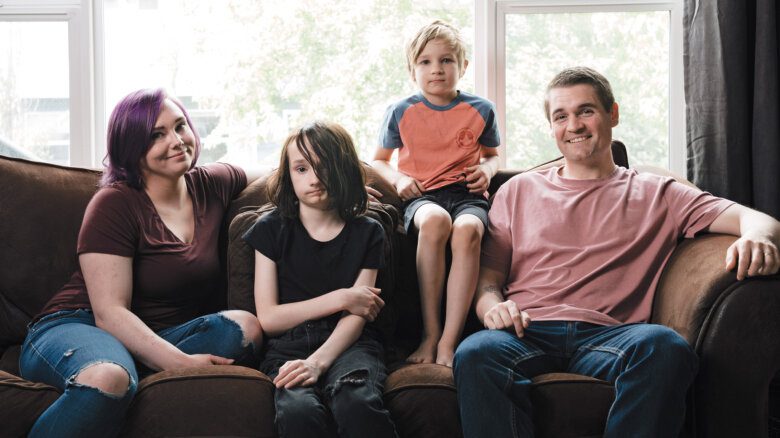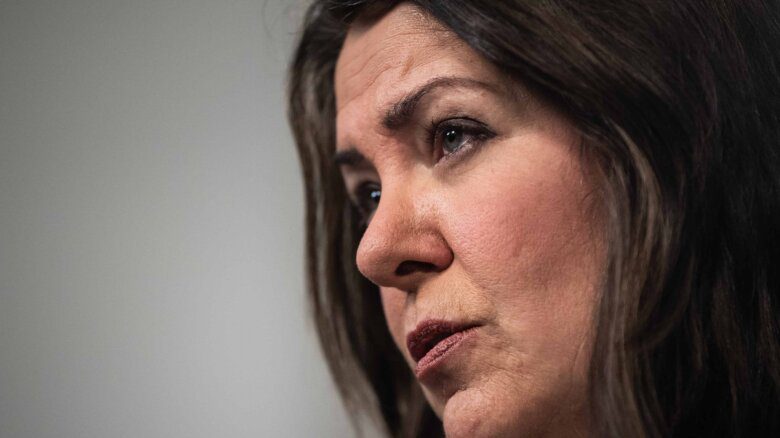This story was produced in collaboration with Chatelaine, Canada’s leading women’s magazine.
Jasper Cervo’s heart is pounding. The 14-year-old’s Apple Watch keeps buzzing while he talks, sending him notifications in bold white text: “High heart rate.”
“I’m sorry,” he says, breaking off mid-sentence for the third time. “I’m really nervous.”
Sitting at his dining room table in Leduc, Alberta, on a March afternoon, Jasper is trying to explain what it’s like to be a trans kid in a province that recently introduced Canada’s most restrictive trans youth policies. His mom, Dani Barnsley, hovers nearby, sipping coffee, while her boyfriend, Aziz Memon, cleans up the kitchen.
The trio, along with Jasper’s older brother, moved into this townhouse recently. There’s a bit of the whole family in the room. A nearby bookcase is filled with tarot decks, feminist politics books and Judy Blume novels. Shelves line the walls, covered to the brim: plants and crystals, a Star Wars Funko Pop!, a crocheted Pokémon plushie Aziz handmade for the kids. Jasper wanted to meet here because home is where he feels most comfortable. Still, the conversation is a hard one to have.
In January, Alberta premier Danielle Smith proposed a slew of gender-identity-related policies, which are set to be implemented this fall. The new rules will require schools to acquire parental notification and consent before using a different name or pronoun for children 15 and under in the classroom (only notification, not consent, will be required for 16- or 17-year-olds). Similar rules were introduced in Saskatchewan and New Brunswick in 2023, but Alberta’s policy went a step further, proposing a ban on access to gender-affirming hormones and puberty blockers for anyone under 16. (Sixteen- and 17-year-olds could access both with parental consent, and children already receiving care will be able to continue).
“There have been some organizations advocating for those treatments to be done younger and younger, and I guess I’m uncomfortable with that,” Smith told CTV’s Power Play in February. When pressed to share what evidence she drew on to inform the policy, Smith admitted it was based on a “concern of what will happen.”
(Smith did not respond to Xtra’s request for comment.)
Jasper has been on a wait-list to receive gender-affirming care for almost two years. He wants to start hormone replacement therapy (HRT) to alleviate the dysphoria he feels over his body and voice. If he doesn’t manage to get it by the fall, he might have to wait another two years, during which he’d likely be forced to go most of the way through puberty. “I’m terrified,” he says.
Alberta’s policy will also ban top and bottom surgeries for anyone under 18. It’s a move critics say is motivated more by politics than reality: in Alberta, only eight people under 18 received gender-affirming top surgeries between 2022 and 2023, while bottom surgery is already banned for minors across the country.
More than 40 groups—including the Alberta Medical Association and Amnesty International Canada—have condemned the policies. The rules run counter to the guidance of major medical associations in Canada and around the world, which endorse gender-affirming medical care for youth when necessary. Studies of trans and non-binary youth have shown that access to age-appropriate, gender-affirming care is associated with better mental health. By contrast, an inability to access such care is correlated with higher rates of suicidality, depression and self-harm.
Despite these facts, politicians have increasingly moved to roll back the rights and freedoms of trans kids, under the guise of protecting them or maintaining “parental rights.”
Jasper’s brother, Aspen, thinks this is a waste of time. The 16-year-old identifies as gender-fluid, but not trans. When he first heard about the policies, he knew they wouldn’t affect him, but he immediately thought about how long his brother had been waiting for gender-affirming care.
Aspen and Jasper fight. Sometimes they butt heads so badly they barely talk. But they care about each other fiercely. In the days following the announcement, Aspen decided he needed to do something to stick up for Jasper and other kids like him, so he led a walkout in protest at his high school. When anti-trans protesters showed up and started yelling, the students stood their ground. Dani, Aziz and the kids’ birth dad, Dalen, were among the parents supervising the protest. They formed a chain, using their bodies to shield their kids from the increasingly aggressive adults opposing them.
Jasper says this gave him hope: “Seeing Aspen be such a big advocate makes me think people might see these policies are wrong. I think what he did was really brave.”
Jasper feels lucky to have a supportive sibling and parents. Because, to be a trans kid in Canada, Jasper knows, is to be forced to navigate a world of contradictions. Kids are told they need protection—from what exactly is not entirely clear—by the same anti-trans protesters who stand outside their schools yelling harmful slogans. They’re told they lack the maturity to participate in their own medical decision-making, but are expected to handle transphobia, bullying and hate with grace. It can be hard, sometimes impossible to navigate alone. But for kids like Jasper with supportive families, home can become a space of support, stability and joy.
“It was like I was watching parts of my kid just fall away.”
Jasper hasn’t always felt hopeful since he came out as trans two years ago. When he first told his parents, they were initially surprised, but supportive overall. They didn’t get everything right—sometimes they’d mess up his name or pronouns—but he could tell they were trying.
Because his parents took his coming out well, Jasper thought others would too. When he enrolled in middle school, he introduced himself to his new classmates using his chosen name and pronouns.
Although Jasper had always been good at making friends, he started to lose them after coming out. Some kids—and their parents—were uncomfortable with him being trans. Then the bullying started. A classmate told everyone what Jasper’s deadname had been, and kids used it to taunt him. Throughout the fall, things escalated. Jasper was bullied when he tried to use the boys’ change rooms at school—and when the bullying drove him to switch back to the girls’ change room, he was bullied there too. Kids shoved him into lockers in the hall. They sent him threats online and yelled at him in the school hallways, telling him he should kill himself. After months, it became too much. Once bubbly and friendly, Jasper started lashing out, getting into physical fights at school. Sometimes he turned his anger inward and harmed himself, which deepened his depression further. He attempted suicide more than once.
“It was like I was watching parts of my kid just fall away,” Dani says. She says she hounded the school’s administration, but they failed to stop the bullying.
Sending Jasper to school started to feel like a risk. “What if today’s the day I get a call saying another kid beat the shit out of Jasper because he’s trans?” Dani says. “That’s when it really hit me that I was parenting a trans child, and the world that trans people live in is so different than everyone else’s world.”
“A lot of people think that parents who support their kids are somehow pushing us to be trans,” Jasper jumps in. “But I don’t think a parent would ever do that—trans people get so much hate in this world.”
Jasper eventually switched to an alternative learning program, which offers more flexible hours and access to counselling. Many of his classmates are LGBTQ2S+, so he feels safer there. Without the constant bullying, he’s able to focus on learning. He started taking an antidepressant, as well as medication to treat ADHD. Things aren’t perfect, but he feels stable.
Trauma, dysphoria and mental illness put up a wall, but that stability has offered the space for joy to occasionally come through. One of Jasper’s favourite recent memories is his 13th birthday. His mom surprised him with an ironic baby-shower-themed party. When Jasper walked in the room, it was decked out with “it’s a boy” posters. There were cookies decorated with the trans flag and a cake and blue gender-reveal confetti poppers.
“I felt like we hadn’t had a ton of moments to celebrate who Jasper is,” Dani says. “I wanted to create a space where Jasper could be proud of himself.”
“When I saw it I was like, ‘Mooom, that’s cringey,” he says, rolling his eyes. “But I thought it was so adorable.”
There have been other, smaller moments too—like when he gets to bake or go for walks with his best friend, Sage; or sing along to Taylor Swift songs with his mom, or watch his favourite show, Hazbin Hotel. He’s a talented artist, and he finds it calming to spend afternoons filling his sketchbook with drawings of the characters he likes the most. In these moments he doesn’t have to think about the hard stuff—he just gets to enjoy being a kid.
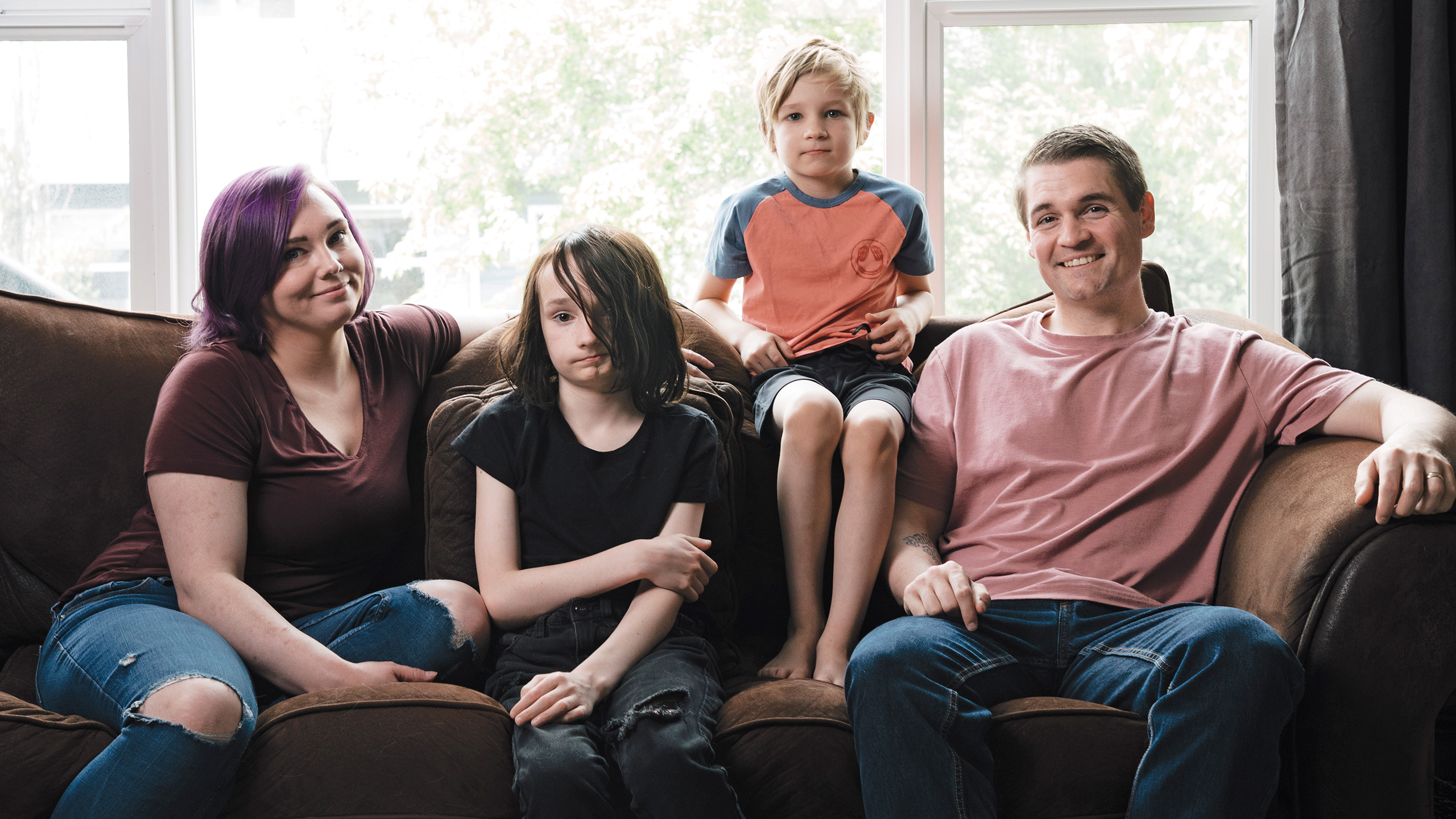
Catie, Samantha, EJ and Chris at their home in Alberta. Credit: Amber Bracken
“It’s got caffeine in it, honey, you can’t have it,” Catie Jones says, flicking her purple hair aside. Her 10-year-old daughter, Samantha, is reaching for the coffee pot in their grey-and-black marbled kitchen.
“Whyyyyy?” Samantha pouts, stepping back. Catie explains that it could interact badly with her medication, and Samantha sighs heavily, then pauses, before perking up when a new idea hits her: “At least if I died, it’d be because I was drinking my favourite drink!”
When you first meet her, Samantha Jones is shy. She keeps her long, sandy hair hanging across her face and talks quietly, holding her hands in front of her mouth. She’s long felt different from other kids, more mature.
Her shyness nonetheless betrays a self-assured streak. At seven, she came home from school and asked her mom for a dress. Earlier that year, a teacher explained to her class that a person could choose the gender that felt best to them. For Samantha, something clicked.
Not long after requesting a dress, she told her parents she wanted to be referred to using the pronouns “she” and “her.” It wasn’t unexpected—she’d previously talked about feeling like she wasn’t in the right body. They told Samantha gender and transition would have to be an ongoing discussion, but they supported her.
Neither wanted to restrict their daughter’s identity. Her mom, Catie, is bisexual, and a conservative upbringing had painfully kept her from coming out until later in life. Although Samantha didn’t know this back then, Catie and Samantha’s dad, Chris, wanted to show her the openness they hoped to receive from others. Still, they had a lot to learn about transness. “I asked for advice from trans adults and started watching videos by young trans people so I could understand better,” Catie says. She and Chris read books about parenting a trans kid.
Samantha lives with her mom and dad—a former steelworker and a pipefitter respectively—along with her eight-year-old brother and the family’s cat and dog in a multilevel house just east of Edmonton. When I visit in March, Samantha greets me in an oversize The Nightmare Before Christmas cardigan and a T-shirt that says “Kindness is badass.” It’s her first day of spring break, and she’s excited to spend the week playing board games with her family and video games with her friends.
Samantha loves buying Slurpees at 7-Eleven and going to the water park at West Edmonton Mall. The day I visit, she’ll be going for a sleepover at a friend’s house, and she can’t wait. Her friend is non-binary, so they get Samantha. Plus, her friend’s parents let the kids stay up until midnight on weekends, and they have better snacks.
Samantha shows me around her house, pointing out her favourite possessions: an amethyst gem with a silver moose on top (a souvenir from her mom’s recent trip to Toronto); her computer, which she set up with a rainbow keyboard. We sit down on the computer room floor, while Catie hovers nearby, pulling books off a shelf, looking for the piece of paper Samantha really wants to show me. After some rummaging, she pulls out two certificates from between the pages of a coffee-table book: one noting a name change and the other an updated birth certificate her parents helped her get. “We wanted her to start off her double digits with her chosen name,” Catie says.
Samantha lays the papers on the floor, leaning over them on her hands and knees. Seeing me eye them, she jumps to cover the one that has her deadname with her hands. “Don’t look at that. Ugh,” she scoffs. When I assure her I won’t, she looks at the second document lovingly.
“This one of my favourite pieces of paper,” she says, touching it lightly.
“Why?” I ask.
“Because it has my name.”
As we talk, the conversation turns toward the news cycle. Samantha sees the news online sometimes. She knows there are people out there who wouldn’t like her just because she’s trans, which she thinks is sad. She also knows a bit about the policies that Alberta plans to introduce. When Catie and Chris talked to Samantha about them, she said she’d already seen them mentioned online.
Samantha grasps that being trans means she’ll have to make important medical decisions for herself in the future. For now, she just has questions. That afternoon in the computer room, she asks her mom a lot of them: If she takes hormones or gets surgery when she’s older, will she still be able to become a parent? Will she still be able to have sex? Will she be happier? Catie answers each to the best of her ability, but ultimately tells Samantha that she has lots of time to figure it all out—they’ll talk to her doctor together when she’s older. For now, she’s still a kid.
Puberty blockers are a slightly more pressing concern. Used to delay puberty, they’re typically prescribed when a child first shows signs of development. They’re meant primarily to allow youth more time to decide whether they’d like to start HRT as an older teen or adult. Puberty blockers’ effects are reversible, while some of the effects of HRT—such as a deepening of the voice for those taking testosterone and the development of breasts for those taking estrogen—aren’t.
When he first heard about them, Chris was curious about puberty blockers and how they worked. When his research showed that they were safe—and could save his daughter from experiencing distress—he was all for them.
When Catie read Alberta’s proposed policy details in February, she cried. Samantha’s doctor had recently diagnosed her with gender dysphoria and suggested she begin blockers when puberty sets in. But Samantha is unlikely to be ready for puberty blockers before the fall, when the policy is set to be implemented, meaning she could be barred from accessing care. Catie thought her family could work with Samantha’s doctor to guide her through medical decisions when the time was right. Now she’s adjusting to the idea that her child might be forced to go through an unnecessary puberty and the increasing distress and dysphoria that often goes with it. Catie feels like she can’t do her job as a parent, she can’t keep her daughter safe.
She says that Samantha became noticeably withdrawn and depressed after they talked about Alberta’s policies. The reactions from kids at school didn’t help. Two days after the policy announcement, Samantha’s teacher asked the students to list different words that started with the prefix “trans” as part of a language exercise. Samantha was excited—this was her moment. She shot up her hand, shaking it with anticipation. When the teacher called on her, she got to offer “transgender,” which felt really cool. But shortly after, a classmate of hers walked by, looked at the trans-flag-coloured eraser she had sitting on her desk, and said, “That’s disgusting.”
That didn’t feel cool at all. Looking for assurance, Samantha asked another classmate, who she considered a friend, whether he agreed with the bully. He told her he did. On the verge of tears, Samantha told her teacher, who sent her to speak with the principal.
Catie got a call soon after that Samantha was in the principal’s office. She drove down immediately. The school took the incident seriously—the principal spoke with the other kids and explained to them that their comments were hateful and wrong. But at the end of the conversation he turned to Samantha and advised her that not broadcasting her identity so loudly might help her avoid bullies.
Catie turned to the principal and told him she strongly disagreed. Then she turned to Samantha. “You’re allowed to be proud of who you are,” she told her. “If you want to tell the world who you are, you do it.”
What Samantha wants the world to know is that she and other kids deserve more credit than they get. “I get that some things are mature and stuff like that, but kids aren’t stupid,” she says.
She doesn’t like it when people pick on those with less power—if she sees a classmate getting bullied, she’ll always step in, even if she isn’t friends with them. And she feels like politicians are picking on kids when they try to limit their rights. “I have to filter myself or I will get out of hand,” she says. “But I think Danielle Smith is targeting kids because she’s weak.”
Samantha knows she’ll have to wait until she’s older to do a lot of the things she wants to do: travel outside of Canada, get a cellphone, play Red Dead Redemption, drink caffeinated coffee. She’s willing to wait for those things. But she’s not willing to wait to be who she knows she is, and she doesn’t think other kids should have to either.
If she were older, she says she’d try to run for premier herself, so that she could protect kids like her. Since she can’t, she’s thankful that her parents can stick up for her. “It feels good to know they’re there,” she says. “I know a lot of parents wouldn’t do what they do.”
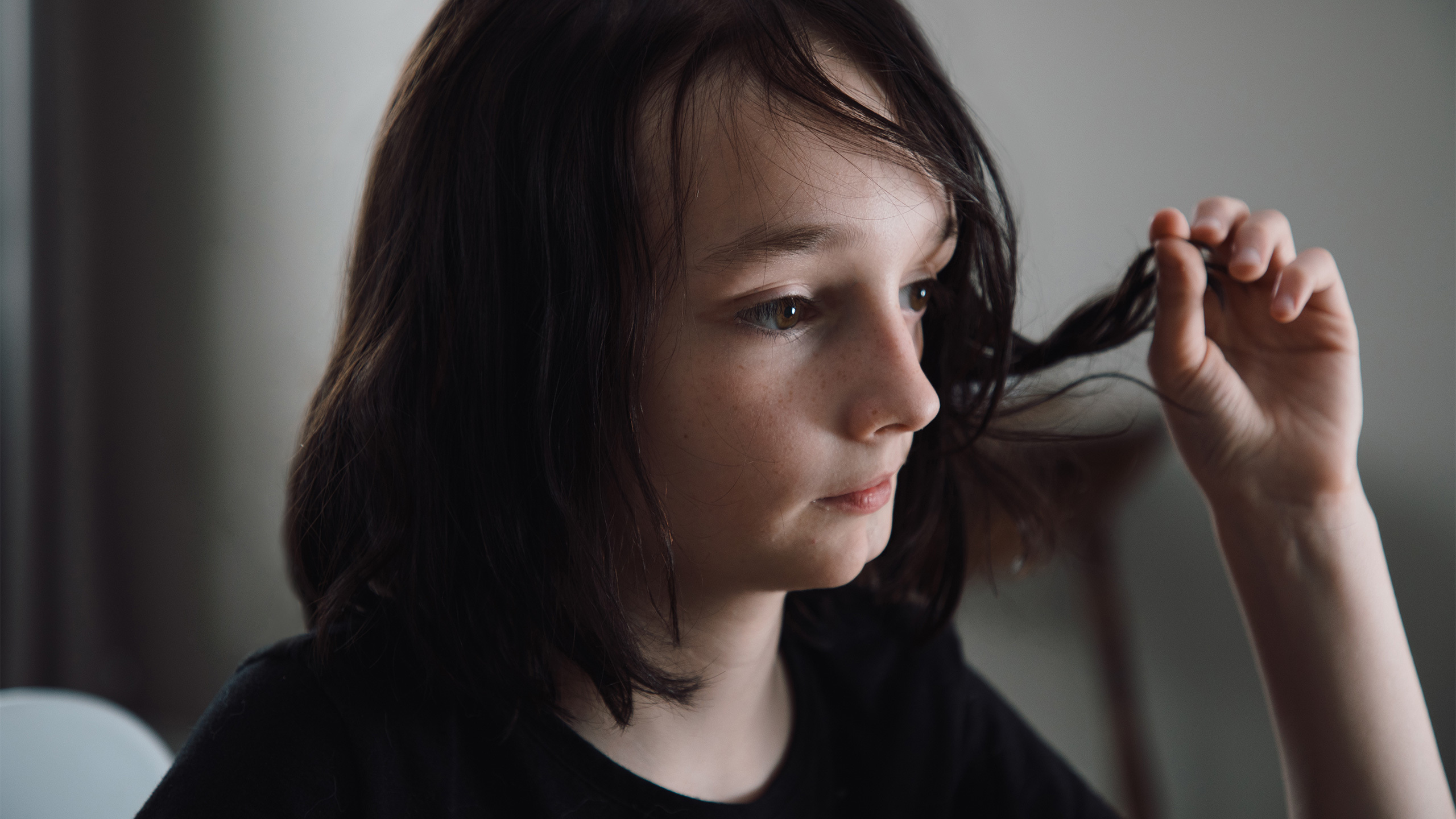
Samantha in her home in Alberta. Credit: Amber Bracken
In Canada, witnessing the rise of anti-trans legislation feels like watching a wave gain momentum. While Alberta, where Jasper and Samantha live, is the only Canadian province that’s indicated its intention to take away access to some medical care, policies limiting children’s rights in schools have been building across the country.
It started last spring, when New Brunswick premier Blaine Higgs placed the Sexual Orientation and Gender Identity policy, or Policy 713, under review. The original policy required schools to support students by using their chosen names and pronouns, but the province rolled back those protections so that students under 16 can no longer change either without parental consent. Language mandating that students be allowed to participate in extracurriculars “consistent with their gender identity” was also removed. This past school year, the changes weren’t applied evenly across the province, and the majority of school districts have maintained contradictory policies despite warnings from education minister Bill Hogan.
Then the wave moved west. Last October, Saskatchewan introduced its “Parents’ Bill of Rights,” or Bill 137, wielding the Notwithstanding Clause to override the Charter of Rights and Freedoms and make it law. Bill 137 includes the same parental notification rules as Policy 713, and changes to the way sex-ed is taught in schools. Parents in the province can now opt kids out of sexual health instruction, and third-party educators—who were often invited to offer inclusive sex-ed instruction—are no longer permitted to teach in schools.
Skylar Forsberg, a 20-year-old Saskatchewan-based teacher’s assistant, worries the rules make it harder for teachers to care for kids. She says educators in the province have been looking for workarounds that allow them to continue supporting LGBTQ2S+ youth—putting “safe space” signs on classroom doors and bringing in counsellors to help queer and trans kids.
Forsberg, who is trans herself, says support from her teachers growing up in Saskatchewan inspired her to work in education. In high school, she recalls, she was able to use the girls’ washroom without pushback. One day, when the board’s superintendent was visiting, though, he stopped her as she tried to enter it, telling her to use the boys’ room instead. Thankfully, school staff intervened and told her to keep using the girls’ washroom. An incident that could have left her feeling depressed and isolated instead affirmed that school was somewhere she wanted to be.
“School’s supposed to be a place for kids to feel safe and to have fun and learn,” she says. “The province shouldn’t be taking away teachers’ ability to create a positive environment.”
Politicians across Canada have indicated gender identity policies are meant to protect children, but critics aren’t convinced. An early draft of Saskatchewan’s policy, many have pointed out, would have allowed teachers to avoid seeking parental consent to use a different name or pronouns for a student if they feared alerting parents would put the child at risk of harm. That provision was taken out before the policy passed. Both Saskatchewan and New Brunswick’s policies remain the subject of ongoing legal challenges (Alberta is seeking intervener status in Saskatchewan’s case, which, if granted, would allow them to make arguments to the court). They’ve received substantial pushback, with protests and student walkouts taking place.
Alex Harris, 17, was one of those protesters in New Brunswick. He helped organize his school’s walkouts last year to advocate for younger trans students. Alex came out as trans a few years before Policy 713 changed and says his experience would have been tougher under the new rules.
Alex had come out as bisexual when he was 12, so once he got to high school, he joined his school’s Gender and Sexuality Alliance (GSA) the first chance he got. Around that time, he started to experience gender dysphoria. He’d known what being trans was for years, but it wasn’t until he reached his teens that he began to understand he was trans himself. Coming to terms with his gender was a relief, but it was also overwhelming. He’d begun turning the same questions over and over in head, a distracting, anxiety-inducing reel: What am I going to do now? How do I go about coming out? How can I make this dysphoria go away?
Alex came out to a handful of other queer kids at his school, keeping a list of who knew and who didn’t in his phone. It helped, but no one could really tell him what to do next. He needed an adult’s support. He thought his parents were likely to be understanding, but wasn’t sure. Coming out to a teacher first would be easiest: if things weren’t okay at home later, he’d have school as a place where he could still be himself.
In 2020, when he was in Grade 9, Alex came as trans to the teacher who ran his school’s GSA. His teacher asked him how he was feeling, and whether he wanted specific questions answered, then walked him through options for coming out at school. She offered to help him talk to his parents once he was ready. Walking away, Alex felt reassured. “I was like, ‘This is going to suck for a bit, but it’ll be okay.’”
Thanks to his school’s policy, Harris was able to take time exploring his identity. “I had support, but teachers weren’t allowed to push my journey faster than I needed it to be.” Without that assurance, he might have struggled alone for longer.
When he did come out to his parents about a month later, his dad, a military veteran and his mom, Jessica, a homemaker and caregiver, took it well. Jessica says she didn’t take it personally that her son hadn’t talked to her first—she was just happy he hadn’t been alone. “I didn’t feel like my rights or authority had been taken away,” she says. She finds it frustrating when other parents do. “It’s not about your child keeping things from you. It’s about their rights to feel safe in their lives,” she says. “Parents are putting their feelings above their children’s rights.”
Jessica was proud of Alex’s independence—and even prouder when he spoke out against Policy 713. The family often volunteers together at a youth organization, so this felt like a natural progression. Jessica doesn’t like being on the front lines—she’s more reserved—but she supported her son quietly, offering him and his friends rides to protests, and granting Alex and his siblings permission to participate in walkouts.
Life got easier after Alex came out. For a while, he got to go back to focusing on just being a kid: “Going for walks with friends, watching Star Trek and Marvel movies and playing Minecraft … even though I’m not in middle school anymore,” he says sheepishly.
Nowadays, at home, Alex says his transness rarely comes up among his immediate or extended family, which he likes. But he can talk about it when he needs to. Whenever Alex has spoken to his doctor about gender-affirming care, his mom has stayed in the room, at his request. For now, he’s decided not to pursue medical transition. If that changes, he’s confident his parents would help.
At school, there are other kids who are out as queer or trans, and they largely stick together. His classmates aren’t always kind, but when bullying happens, school staff try to intervene. Since Policy 713 was revised, those situations have become more frequent. In the past, Alex would get a homophobic name-calling here and an insult there—nothing that felt major. But as the political discourse has shifted in the province, so has the social climate among his peers. When Alex hugs his friends in the hallways, he gets taunted. When he walks home, kids yell at him from cars. He refuses to pass through certain parts of the school if he knows teachers won’t be there, because he fears becoming a target.
“This never happened before,” he says. “It’s so frustrating. It’s like, just leave me alone. Please.”
Alex would rather focus on being an overachiever; his list of extracurriculars includes yearbook, school tech crew, cadets and volunteering.
The bullying hurts Jessica too. “It’s devastating to know that even a kid as stable and independent and well supported as Alex is struggling,” she says. “It scares me to think of kids that aren’t as able to shrug these things off. There’s a mental anguish being inflicted on these kids.”
What keeps Alex going is how close he is to graduating. Next year he’ll move away to start a journalism program, where he’ll blend his love of storytelling and social justice.
What keeps his parents going is the pride they have in the person their child is becoming. “He’s going to be able to advocate,” Jessica says. “He’ll be a leader to youth and can say, ‘Hey, I’ve been there. I’ve done this. And, you can too.’”
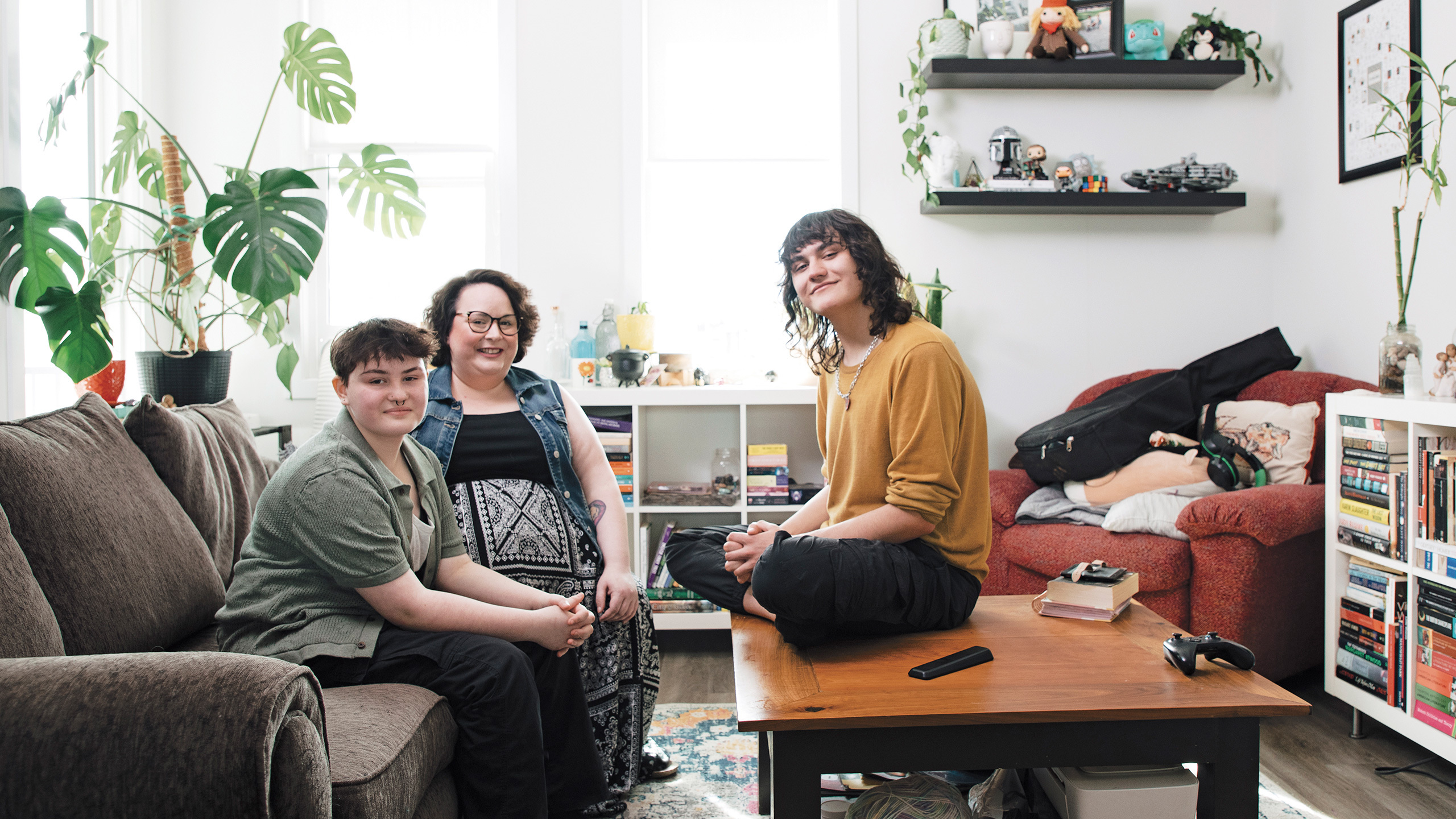
Jasper, Dani and Aspen at their home in Alberta. Credit: Amber Bracken
The second time I meet with Jasper’s mom, Dani, she’s thinking about the future. It’s a classic kind of prairie day in March, where the cold is biting, but the sun is piercing bright. It streams through the family’s front windows, into the living room. Jasper sits on the couch across from his mom, barefoot, the hood of his sweatshirt pulled up over his ears and his knees folded up to his chest. He’s half-listening to Dani talk, half-texting his friends.
The pair had been reflecting on the bullying Jasper experienced, and Dani’s assuring him that things will change. In a couple of years his classmates will likely be more mature, less mean. By the time he gets to university or college he’ll meet more open-minded people—he’ll probably form a community of his own. Jasper raises his eyebrows, but doesn’t look up from his phone, seemingly unconvinced. He doesn’t have faith in most people.
He nevertheless has his own hopes for the future. In the short term, he’s considering going back to dance classes, an activity he loved, but stopped when he first transitioned. Long term, he wants to get a job that allows him to help people. He might become a therapist or a doctor.
Jasper hopes to leave Alberta one day. It’s just not fun to be there anymore. His mom has Scottish ancestry, and he thinks maybe living in Scotland could be better.
If he goes, though, he wants his mom to come with him. Even when he was at his angriest, when he pushed her away or took his pain out on her, she loved him anyway. When she messed up, she tried to do better. He knows she’ll always be in his corner.
“If I can’t fight, Mom will fight.”
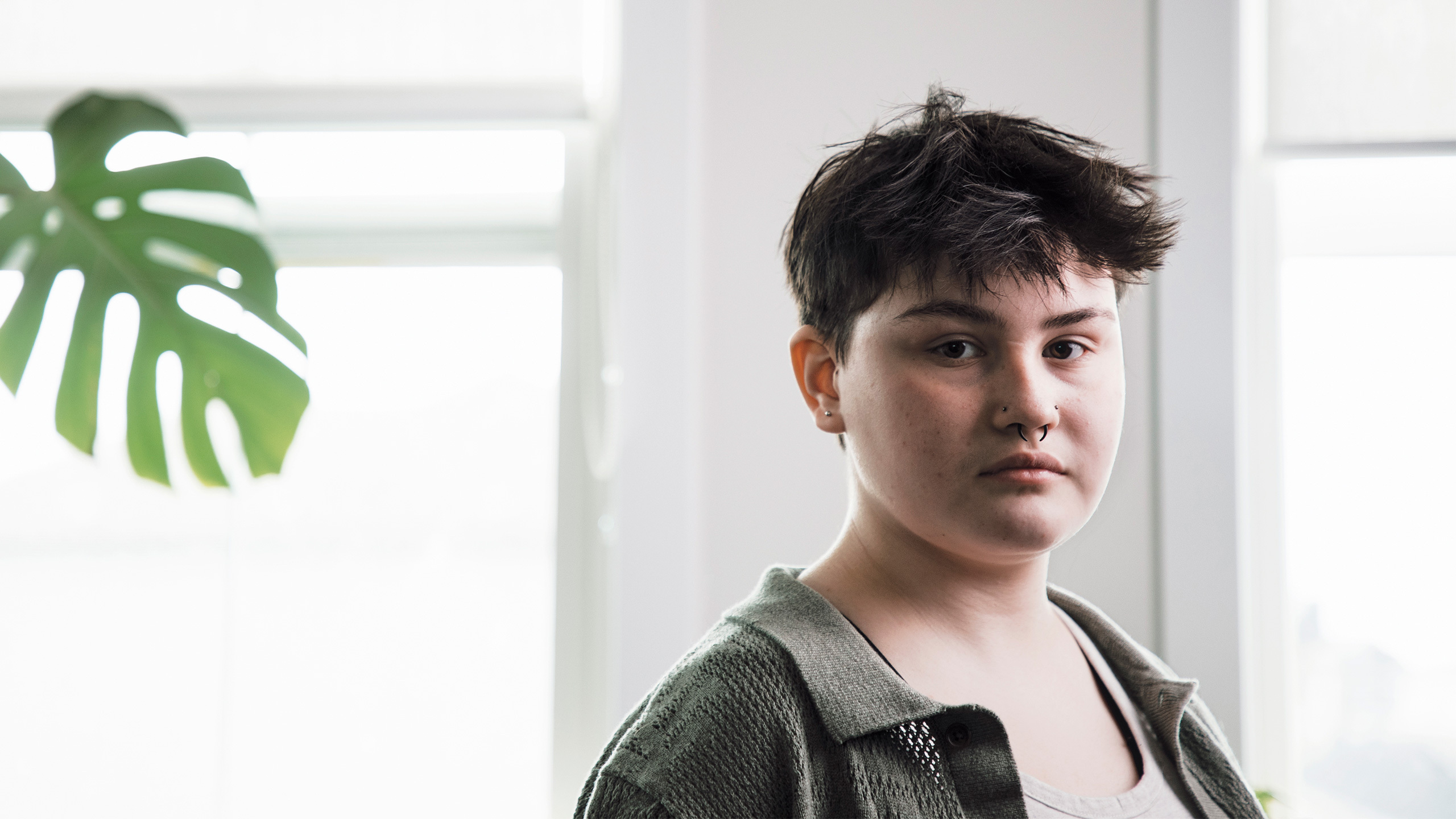

 Why you can trust Xtra
Why you can trust Xtra